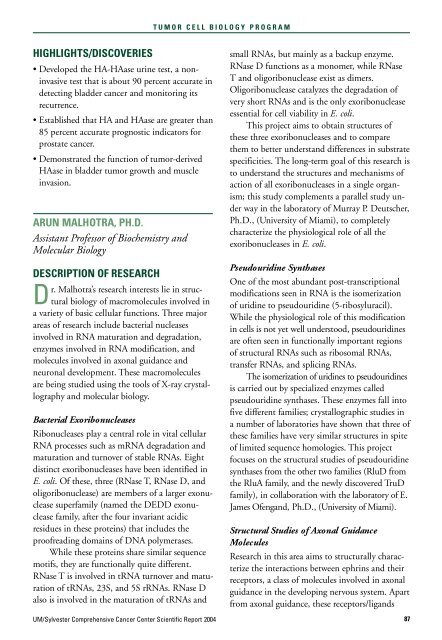SCIENTIFIC REPORT 2004 - Sylvester Comprehensive Cancer Center
SCIENTIFIC REPORT 2004 - Sylvester Comprehensive Cancer Center
SCIENTIFIC REPORT 2004 - Sylvester Comprehensive Cancer Center
Create successful ePaper yourself
Turn your PDF publications into a flip-book with our unique Google optimized e-Paper software.
T U M O R C E L L B I O L O G Y P R O G R A M<br />
HIGHLIGHTS/DISCOVERIES<br />
• Developed the HA-HAase urine test, a noninvasive<br />
test that is about 90 percent accurate in<br />
detecting bladder cancer and monitoring its<br />
recurrence.<br />
• Established that HA and HAase are greater than<br />
85 percent accurate prognostic indicators for<br />
prostate cancer.<br />
• Demonstrated the function of tumor-derived<br />
HAase in bladder tumor growth and muscle<br />
invasion.<br />
ARUN MALHOTRA, PH.D.<br />
Assistant Professor of Biochemistry and<br />
Molecular Biology<br />
DESCRIPTION OF RESEARCH<br />
Dr. Malhotra’s research interests lie in structural<br />
biology of macromolecules involved in<br />
a variety of basic cellular functions. Three major<br />
areas of research include bacterial nucleases<br />
involved in RNA maturation and degradation,<br />
enzymes involved in RNA modification, and<br />
molecules involved in axonal guidance and<br />
neuronal development. These macromolecules<br />
are being studied using the tools of X-ray crystallography<br />
and molecular biology.<br />
Bacterial Exoribonucleases<br />
Ribonucleases play a central role in vital cellular<br />
RNA processes such as mRNA degradation and<br />
maturation and turnover of stable RNAs. Eight<br />
distinct exoribonucleases have been identified in<br />
E. coli. Of these, three (RNase T, RNase D, and<br />
oligoribonuclease) are members of a larger exonuclease<br />
superfamily (named the DEDD exonuclease<br />
family, after the four invariant acidic<br />
residues in these proteins) that includes the<br />
proofreading domains of DNA polymerases.<br />
While these proteins share similar sequence<br />
motifs, they are functionally quite different.<br />
RNase T is involved in tRNA turnover and maturation<br />
of tRNAs, 23S, and 5S rRNAs. RNase D<br />
also is involved in the maturation of tRNAs and<br />
small RNAs, but mainly as a backup enzyme.<br />
RNase D functions as a monomer, while RNase<br />
T and oligoribonuclease exist as dimers.<br />
Oligoribonuclease catalyzes the degradation of<br />
very short RNAs and is the only exoribonuclease<br />
essential for cell viability in E. coli.<br />
This project aims to obtain structures of<br />
these three exoribonucleases and to compare<br />
them to better understand differences in substrate<br />
specificities. The long-term goal of this research is<br />
to understand the structures and mechanisms of<br />
action of all exoribonucleases in a single organism;<br />
this study complements a parallel study under<br />
way in the laboratory of Murray P. Deutscher,<br />
Ph.D., (University of Miami), to completely<br />
characterize the physiological role of all the<br />
exoribonucleases in E. coli.<br />
Pseudouridine Synthases<br />
One of the most abundant post-transcriptional<br />
modifications seen in RNA is the isomerization<br />
of uridine to pseudouridine (5-ribosyluracil).<br />
While the physiological role of this modification<br />
in cells is not yet well understood, pseudouridines<br />
are often seen in functionally important regions<br />
of structural RNAs such as ribosomal RNAs,<br />
transfer RNAs, and splicing RNAs.<br />
The isomerization of uridines to pseudouridines<br />
is carried out by specialized enzymes called<br />
pseudouridine synthases. These enzymes fall into<br />
five different families; crystallographic studies in<br />
a number of laboratories have shown that three of<br />
these families have very similar structures in spite<br />
of limited sequence homologies. This project<br />
focuses on the structural studies of pseudouridine<br />
synthases from the other two families (RluD from<br />
the RluA family, and the newly discovered TruD<br />
family), in collaboration with the laboratory of E.<br />
James Ofengand, Ph.D., (University of Miami).<br />
Structural Studies of Axonal Guidance<br />
Molecules<br />
Research in this area aims to structurally characterize<br />
the interactions between ephrins and their<br />
receptors, a class of molecules involved in axonal<br />
guidance in the developing nervous system. Apart<br />
from axonal guidance, these receptors/ligands<br />
UM/<strong>Sylvester</strong> <strong>Comprehensive</strong> <strong>Cancer</strong> <strong>Center</strong> Scientific Report <strong>2004</strong> 87
















